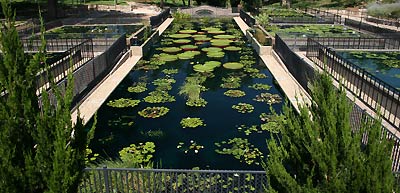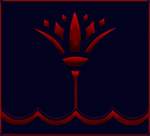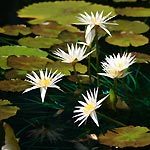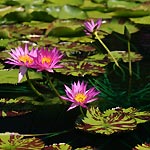
A Place to Fuel the Imagination.
Nuphar
| IWC Home |
| About Us |
| Latest News |
| The Plants |
| The Collection |
| Water Gardening Info & Tips |
| Resources |
| Site Map |

| Nuphar |
None of the Nuphar listed below are in the IWC collection. Mr. Landon works to preserve the Nymphaea as best he can but does not store and grow out the Nuphar. This information is for educational purposes only. The genus Nuphar was at one time synonymous with Nymphaea. Nuphars are hardy perennials. Nuphars usually grow from thick rhizomes growing in mud in ponds, lakes or streams in water up to 10 ft deep. A few, N. japonica and N. lutea subsp. sagittifolia are exceptions and produce small rhizomes that are suitable for growing in aquariums. Nuphars start out as day bloomers but may change to be day and night blooming.
The following exerpt was taken from http://www.efloras.org "1. Nuphar Smith in J. Sibthorp & J. E. Smith, Fl. Graec. Prodr. 1: 361. 1809. Spatterdock, cow-lily, yellow pond-lily, nénuphar [ancient Arabic or Persian name] Rhizomes branched, repent; stolons absent. Leaves floating, submersed, or emersed. Leaf blade orbiculate to linear, basal lobes divergent to overlapping, margins entire, apex of lobe narrowly obtuse to broadly rounded; primary venation mostly pinnate, basal section of midrib with several parallel veins. Flowers floating or held above surface of water, opening diurnally; perianth hypogynous, not spreading, nearly globose at anthesis; sepals 5-9(-12), outwardly yellow to green, becoming yellow within, often red-tinged, oblong or obovate to somewhat orbiculate; petals numerous, spirally arranged, inconspicuous, stamenlike; stamens yellow- or red-tinged, inserted below ovary, recurved at dehiscence, distal connective appendage absent; ovary longer than petals and stamens; stigmatic disk with margin entire to crenate or dentate, appendages absent. Fruits borne on straight peduncles. Seeds ovoid, to 6 mm; aril absent. x = 17. Species 10-12, most intergrading and sometimes treated at subspecies rank (8 in the flora): north temperate, North America, Europe, and Asia. The taxonomy of the genus is problematic. E. O. Beal (1956) departed dramatically from previous North American treatments in recognizing a single polymorphic species, Nuphar lutea (name of European origin), with several subspecies formerly treated as species. Subsequent research (C. E. DePoe and E. O. Beal 1969; E. O. Beal and R. M. Southall 1977) has supported Beal's treatment for some southeastern subspecies, but most other taxa have not been studied as extensively. Beal's treatment, for the most part, has not been adopted in the Northeast and elsewhere in North America or in Europe. Molecular studies of Nuphar currently in progress (D. J. Padgett, pers. comm.) have clearly shown the North American taxa to be distinct from the Eurasian Nuphar lutea ; Beal's nomenclature under that taxon cannot be upheld. Continuing to treat those taxa at subspecific rank would require new combinations under Nuphar sagittifolia (Walter) Pursh, the oldest name that has hitherto been applied only in a geographically restricted sense. Until the molecular studies are completed, creating new names is premature. We therefore return to the previous treatment of the taxa as species. Prior to conservation in its current sense, the name Nymphaea was frequently used for Nuphar . Although often treated as neuter, Nuphar was originally assigned the feminine gender (W. T. Stearn 1956; H. W. Rickett and F. A. Stafleu 1959)." Please follow the link to get a more in depth study on Nuphar.
These pictures were provided by Garet Uemura and the names given are the names listed. As you can see from the information above, there is still today some differing opinions on the taxonomy of the species. We do not claim to know the final and correct outcome but would just like to show another possibility for the pond growing enthusiast. Nuphar japonicum var. Variegatum Nuphar japonicum var. rubotinctum Nuphar pumilum var. ozeense
|
| New Star Lilies | ||
|
|
||

